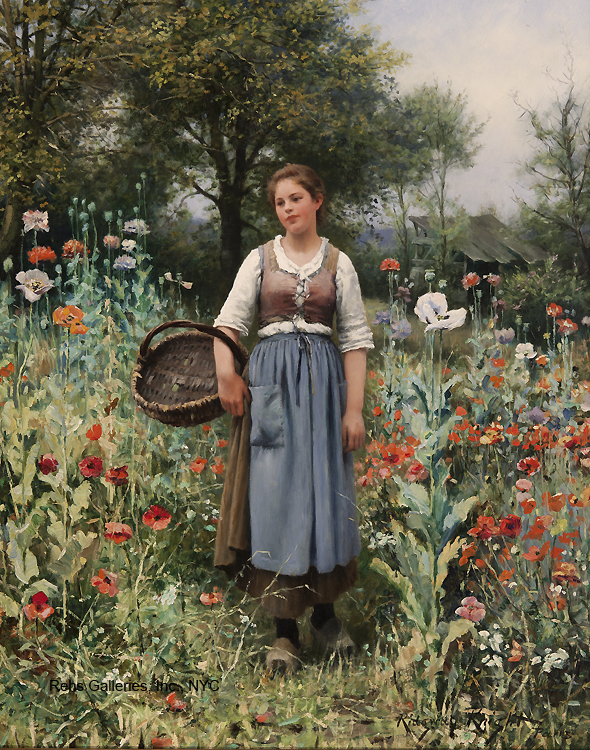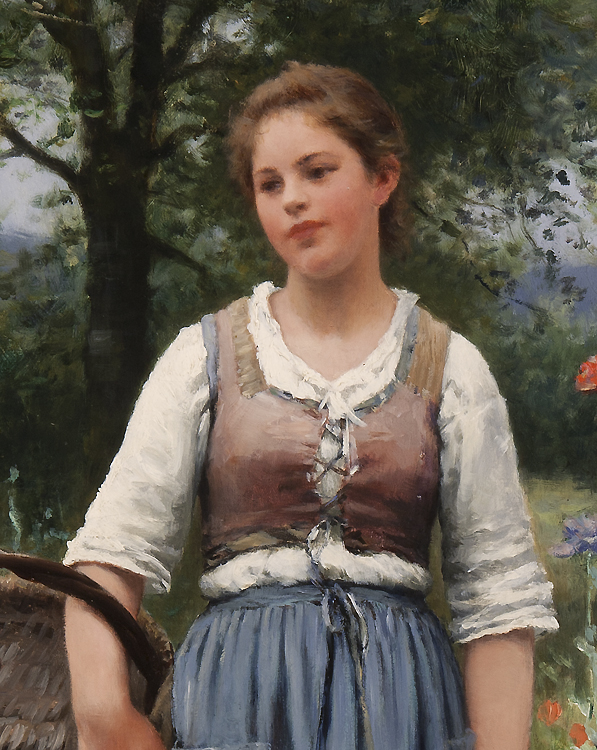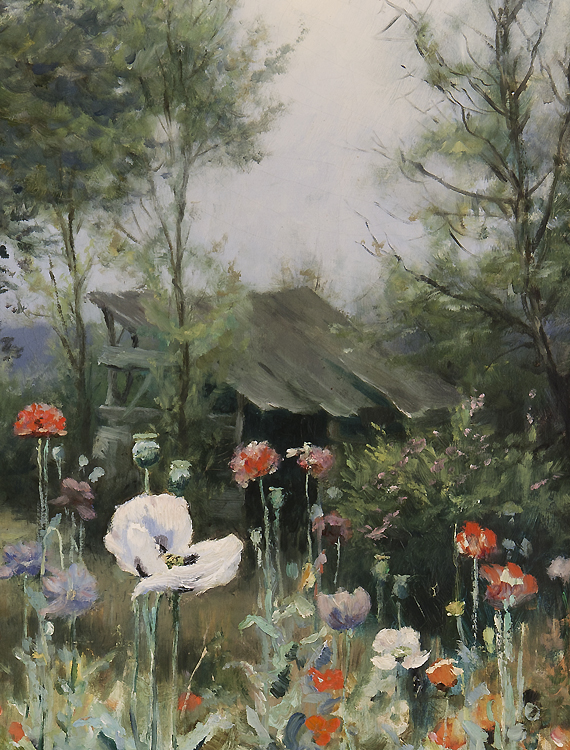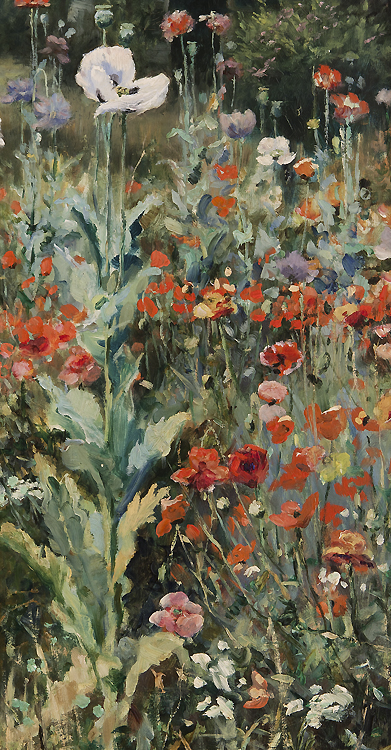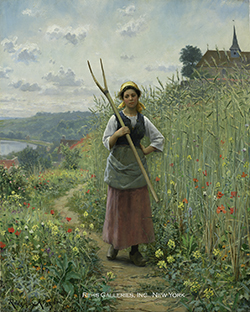Daniel Ridgway Knight
(1839 - 1924)
Among the Poppies
Oil on canvas
32 1/2 x 26 inches
Signed and inscribed Paris
BIOGRAPHY - Daniel Ridgway Knight (1839 - 1924)
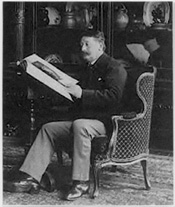
The American painter Daniel Ridgway Knight spent most of his career in France, but his early life took place in Philadelphia, which was a cultural center for the visual arts throughout the nineteenth century. Knight was born on March 15, 1839 to Robert Tower Knight and Anna Shyrock. He was baptized on August 18, 1839, at St. George Methodist Episcopal Church in Philadelphia. [1] He was the third child, and first son, in the family; two other siblings would follow in the ensuing years. Robert Knight was listed in the 1870 US federal census as a carpenter and builder; in the 1880 census, he was listed as a civil engineer.
Little is known about Knight’s early schooling or how he developed an interest in the visual arts. Perhaps his father’s work as a builder and engineer introduced him to the study of design. After completing his basic education, he enrolled at the Pennsylvania Academy of Fine Arts, probably in the late 1850s, where he received some basic instruction in art and began to study painting. Undoubtedly Knight would have been exposed to a variety of artistic trends, including the French academic tradition and the teaching methods prevalent at the Ecole des Beaux-Arts in Paris. More interesting to a young art student, however, the school hosted its first “blockbuster” exhibition in 1858 when Knight was studying there. The exhibition, entitled Modern British Art in America, toured New York, Philadelphia and Boston, all cultural centers with thriving arts communities. The show featured the work of the Pre-Raphaelite Brotherhood, displaying 105 oil paintings and 127 watercolors at the Philadelphia exhibition. Local critical reactions were mixed. The Pennsylvania Inquirer claimed that “the surprising excellence of many of the specimens so far exceeded our anticipation that they excited surprise as well as intense admiration” while the Sunday Dispatch had few positive remarks to offer, noting that the Pre-Raphaelite paintings were rigid, false and too “Catholic”.[ii] For the students at Pennsylvania Academy of Fine Arts, the exhibition provide a glimpse of what was then experimental European art unlike anything they had seen before. Among others, the artists represented included Ford Madox Brown, whose paintings of King Lear and The Light of the World were very well received; in addition, there were works by John Ruskin, Elizabeth Siddal, William Holman Hunt, and J. R. Spencer Stanhope. The influence of these painters on Knight’s later work is particularly evident in his attention to richly textured landscapes.
The next few years in Knight’s career were full of new experiences. He is registered in the 1860 US federal census as still living in his parents’ home in Philadelphia in the spring, but it is likely that he left for Paris shortly thereafter. [iii] Once in Paris, he applied to the Ecole des Beaux-Arts, but began to work in the atelier of the Swiss painter, Charles Gleyre (1806-1874), who had taken over Paul Delaroche’s studio in 1843. Gleyre had no teaching experience when he agreed to take on Delaroche’s students, but he turned out to be an insightful and progressive studio master. [iv] When Knight arrived, there were at least two other young Americans studying with Gleyre, Edward Larson Henry (1841-1919) and William Mark Fisher (1841-1923). Henry had also studied at the Pennsylvania Academy of Fine Arts in the late 1850s, so he and Knight would certainly have been acquaintances, if not friends. By 1862, there were several other notable students working at Gleyre’s atelier, which had by then developed a reputation for being an innovative and open-minded environment. Those students included Pierre Auguste Renoir, Frédéric Bazille, Alfred Sisley and occasionally Claude Monet. There are no records indicating whether Knight and his American colleagues interacted with the young Impressionist painters, but surely, there must have been lively conversations in the studio. During this time, Knight was also studying at the Ecole des Beaux-Arts, where he matriculated in 1861. [v]
In 1863, both Knight and Edward Larson Henry returned to the United States, probably because of the passage of The Draft Act, which required that all male citizens were subject to compulsory conscription. There is no record that Knight was ever called to serve. The explanation may lie in the fact his return to the US occurred after the Battle of Gettysburg on July 1-3, 1863. Although losses on both sides were horrendous, it would prove to be a turning for the Union Army; the Confederate forces retreated across the Potomac River and would never again venture into the Union territory.
Back in Philadelphia, Knight established his own studio where he took on his own pupils. One of them was a young woman named Rebecca Morris Webster (1849-1912), whom Knight would marry on September 20, 1871, in St. Luke’s Episcopal Church. [vi] Just a few months later, the newlyweds traveled to France, settling first in Paris and ultimately in the town of Poissy about fifteen miles northwest of Paris. Knight’s primary reason for moving to Poissy was the presence of Ernest Meissonnier (1815-1891), a painter he much admired. Meissonnier had purchased a mansion there in 1846 at the height of his artistic success and created both a winter studio (at the top of the house) and a summer studio (in a glass-roofed annex). There he would work with a selected number of students, including his own son Charles, and after 1872, Daniel Ridgway Knight. The two families would be life-long friends.
The early years in Paris are largely undocumented except for the birth of the Knight’s first child, Louis Aston Knight on August 3, 1873. By 1876, Knight was living in Poissy at 1 rue de Paris in the center of town. The 1876 census, however, lists only Knight himself, not his family at this address. Whether Rebecca and Louis were still living in Paris, or perhaps living with the Meissonnier family nearby is unknown. In the immediate aftermath of the disastrous Franco-Prussian War of 1870-71, an artists’ colony of sorts had grown up around the Meissonnier family properties in Poissy. An abandoned abbey known as the Abbaye had been converted into what we might now call artists live/work space. In other words, there was room for family life as well as studio space for working artists. Charles Meissonnier (1844-1917) and Lucien Gros (1845-1913) both lived there along with their families and servants. There is no doubt that Knight also spent considerable time working there.
Knight’s painting during these years benefitted from the artistic ferment of the post-war era. His former studio-mates from Gleyre’s atelier were creating a stir with their exhibitions of avant-garde art in venues that were independent of the official Salon. The Barbizon generation that revolutionized landscape painting beginning in the 1830s and continuing on through the Realist movement of the 1850sand 1860s were at last being honored as visionary artists, and yet another group of naturalist painters such as Jules Bastien-Lepage and Julien Dupré were just emerging. Knight’s work was closest to that of the naturalist painters, all of whom owed a debt to the earlier work of Jean-François Millet, whose death in 1875 prompted a re-evaluation of his work. Some of Knight’s most ambitious compositions date from this period. He too was intrigued with rural scenes of working people, such as Les Laveuses (Washerwomen), his 1875 submission to the annual Salon.
The 1870s also brought sad news. Knight’s father Robert died in 1873 followed by his mother Anna in 1879. And in between the deaths, a second child, Charles Meissonnier Knight, was born on November 27, 1877, in Poissy. As France recovered from the destruction caused by the Franco-Prussian War, more and more American artists began to arrive. Many were attracted to Paris of course, but there were also significant American artists colonies in Brittany and at Giverny near Monet’s home in Normandy. Knight seems to have spent some time painting in Brittany, although he was never part of any of the numerous artists colonies there.
In Paris, the Knight family belonged to the American Cathedral Church of the Holy Trinity, one of the uniquely American gathering places in the city. [vii] Known colloquially as the “American Cathedral of Paris”, this Episcopalian church is located on the Avenue George V, just off the Champs-Elysées in one of the wealthiest quarters of the city. It was founded by expatriate Americans in the 1830s and gradually grew in size and scope until it became a significant cultural center for English-speaking residents of Paris. In fact, the French artist Jean Béraud found the sight of American artists exiting the church on a Sunday morning to be a spectacle worth painting. His painting, After the Service at Holy Trinity Church, Christmas, 1890, depicts the fashionable crowd after Christmas services as they exit the Gothic Revival church into a wintry, grey Paris day. The French and US flags hanging above the main entrance provide a colorful counterpoint. Today, the original painting hangs in the Carnavalet Museum, but there is also a réplique at the cathedral. Well-known members included John Singer Sargent and James McNeill Whistler when he was in town, but more importantly, it was a place where all American artists could congregate for social activities and conversation. Daniel Ridgway Knight was actively involved in helping to plan and design the frequent exhibitions that were held at the church. [viii]
The decade of the 1880s brought continued success. Knight’s paintings were selling well, and he had an established reputation in mainstream art circles. In the early 1880s, the family was living on the rue de Paris in Poissy, but the birth of a third son, Raymond, in 1883 seems to have prompted a move to larger quarters. It was at this point that Knight purchased a large 17th-century house on the rue des Dames in Poissy; in addition to the family, it housed four servants, some of whom may have occasionally posed for Knight’s paintings as well. The house itself was very imposing; three stories high with large reception rooms full of ornate Louis XIII-style furnishings, and of course, abundant studio space. The extensive garden also provided a picturesque background for Knight—and eventually his son Louis—to stage vignettes for painting.
Knight’s career flourished during this period. His painting entitled Hailing the Ferry not only won a third-class medal at the Salon of 1888, but also a silver medal at the annual Munich exhibition that same year. The following year, the city of Paris celebrated the centennial of the French revolution (1789) with an extravagant international exposition. The crowning attraction—and the most controversial—was the Eiffel Tower, a tribute to France’s industrial recovery after the Franco-Prussian War as well as a very public statement of the national commitment to a republican form of government based on the concept of liberty, equality and brotherhood for all. In this heady atmosphere, Knight received a silver medal for a painting at the Exposition Universelle, and on November 27, 1889, was inducted into the French Legion of Honor. He would subsequently become an officer of the Legion on January 26, 1909. [ix]
The 1890s opened with considerable optimism as France celebrated its prosperity as well as its revitalized leadership role in international affairs. American artists continued to stream into the country in ever-growing numbers. Some would stay for a few months, some for a few years, and some for most of their lives. Daniel Ridgway Knight certainly looked like one of the lifetime expatriates when the decade opened. He had settled into a comfortable existence in Poissy, having purchased a substantial property, enjoyed an artistic career that was rewarding both financially and personally. The 1891 census for Poissy lists the Knight family living on the rue des Dames, as they had been for at least seven years; five years later, there is no record of them in any census, either in Poissy or Paris. Nor is there any record of them living in the village of Rolleboise, where Knight would later purchase property.
Although this period remains largely undocumented, there are two facts that suggest an explanation for the abrupt disappearance of the entire Knight family from French records. First is the death of Rebecca’s father Thomas Webster on December 30, 1894, in Philadelphia. Second is the decision by the Pennsylvania Academy of the Fine Arts to honor Daniel Ridgway Knight with the Grand Medal of Honor in 1896. Together, these events suggest that the family may have returned to Philadelphia for the funeral of Thomas Webster, and that Knight’s presence in the city prompted his former school to recognize the work of their now internationally recognized alumnus.
A trip to Philadelphia may also have been necessary so that Rebecca could participate in the legal distribution of her father’s estate. This is supported by the 1901 Poissy census where Rebecca reappears as the “chef” (head of household), now living on the avenue Meissonnier. Her legal status is listed as rentier, which indicates that she was a “person of private means”. Her sons and husband are also listed as members of the household, along with four servants. The additional financial security may have been an incentive for Knight to purchase property in the riverside village of Rolleboise, 25 miles northwest of Poissy (and 5 miles southeast of Monet’s home in Giverny). The population, then as now, has never topped 400 people. [x] According to a 1901 article in Brush and Pencil, Knight “secured a house with a fine garden, and built himself a studio” on a site midway between the river and top of the surrounding bluffs. [xi] The location is extraordinary; Rolleboise sits at the beginning of an oxbow curve in the Seine, giving it not only dramatic views northeast along the river bend, but also across a lush field to views of the river as it returns southwest to resume its course to the sea. Knight built a glass house studio there and appears to have taken up permanent residence in Rolleboise along with his son Louis and two female servants. Back in Poissy, Rebecca remained at home on the avenue Meissonnier with her youngest son Raymond, then 23 years old. Charles Knight, aged 29 when the 1906 census was taken, had moved to Paris where he had finished his architectural studies, married Alice Boucherie in 1903, and established his own design firm. [xii]
Daniel Ridgway Knight, often accompanied by Louis, spent about a decade living and working in Rolleboise. It was there that Knight’s imagery is almost exclusively devoted to young women posed in the rich variety of landscapes near Rolleboise. These works were extremely popular, both in Europe and in the US. The retreat to the country would be interrupted by the outbreak of war in 1913. As the German Army advanced on France, foreigners living in France were asked to leave. In the case of other Europeans, they were required to leave, but Americans had a somewhat more negotiable position because the United States was neither at war with any nation nor a potential threat to France. [xiii] For Daniel Ridgway Knight, the decision to return to the US may have been informed by other considerations as well. His son Louis had married an American woman, Caroline Ridgway Brewster on October 15, 1907, in Somerset, New Jersey, and was living in New York much of the time. Then his wife, Rebecca Knight had died in August 1909, leaving her house to her son Charles and his growing family. [xiv]. Two years later, on October 22, 1911, Raymond Knight died of an overdose of morphine while living in Paris.
Although documentation from 1913-1919 is not always complete, there are records of passport applications through the US embassy in Paris. These indicate that Louis Aston Knight left the US in March 1914 and returned to Paris. His passport application for future travel as a US citizen was approved on January 15, 1915. Charles Meissonnier Knight received his initial US passport on July 29, 1915, claiming that he would be traveling to the US within a year. It was updated again in January 1919. Both Charles and Louis based their passport applications on the fact that their father was an American citizen, even though they had been born in France. Finally, Daniel Ridgway Knight applied for a passport at the American embassy in Paris in March 1915, stating that he was living in Paris at 53, rue de Clichy, in the 9th arrondissement just a few blocks south of the Moulin Rouge. These applications suggest strongly that all three men were traveling somewhat regularly between the US and Paris during the war years, whether for business or family concerns. It must be noted that passports were considerably less common and only haphazardly regulated at the outset of World War I. [xv]
Particularly troubling is the disposition of the houses at both Rolleboise and Poissy. The family home in Poissy was requisitioned during World War I, suffering considerable damage and potentially the loss of many of Knight’s artworks. [xvi] The home and studio at Rolleboise seems to have survived World War I with minimal damage, although it is not yet clear if Knight continued to paint there. The Paris address on his passport application probably represents his final residence. Both Charles and Louis also lived in Paris in the 1920s; Charles at 11 rue Marbeuf in the stylish 8th arrondissement and Louis at 147 rue de la Pompe. in the more modern 16th arrondissement. Their addresses indicate that they were all financially secure. Daniel Ridgway Knight died at the American Hospital in Neuilly-sur-Seine on March 9, 1924. He was 85 years old. His funeral service was held at the Church of the Holy Trinity, the American Cathedral of Paris that had been such an important part of his life. He was buried next to Rebecca in the cemetery at St. Germain-en-Laye just outside of Poissy.
Janet Whitmore, Ph.D.
Selected Works In Museum Collections
The Burning of Chambersburg, Pennsylvania (1867) - The Washington County Museum of Fine Arts, Hagerstown, MD.
Scene from Faust - Arizona State University Art Museum, Tempe, AZ.
Peasants Lunching in a Field (1875) - Chrysler Museum, Norfolk, VA.
Market at Poissy (1876) - The Museum at Drexel University, Phil., PA.
At the Well (1880) - Brooklyn Museum, Brooklyn, N.Y.
Rural Courtship (n.d.) - Gilcrease Museum, Tulsa, OK.
Waiting for the Ferry (1885) - Heckscher Museum, Huntington, NY
Noonday Meal (1887) - Haggin Museum, Stockton, CA.
Hailing the Ferry (1888) - Pennsylvania Academy of the Fine Arts, Phil., PA.
The Water Carriers (1892) - Detroit Institute of Arts, Detroit, MI.
The Shepherdess (1896) - Brooklyn Museum, Brooklyn, N.Y.
The Trysting Place (n.d.) - Haggin Museum, Stockton, CA.
Springtime (n.d.) - Albright-Knox Art Gallery, Buffalo, N.Y.
The Gossips (n.d.) - The Pennsylvania Academy of the Fine Arts, PA.
Noonday Meal (n.d.) - Carnegie Institute, Museum of Art, Pittsburgh, PA.
Life is Sweet (n.d.) - Butler Institute of American Art, Youngstown, OH.
Landscape at Swickley PA. (n.d.) - Springville Museum of Art, Springville, UT.
The Idler (n.d.) - Columbus Museum of Art, Columbus, OH.
Girl by a Stream (n.d.) - Minneapolis Institute of Arts, Minneapolis, MN.
Brittany Girl Fishing (n.d.) - Museum of Fine Arts, St. Petersburg, FL.
The Roses (n.d.) - J.B. Speed Museum, Louisville, KY.
The Letter - Joslyn Art Museum, Omaha, NB.
French Thrift - Joslyn Art Museum, Omaha, NB.
Notes
[i] Archives, St. George’s Methodist Episcopal Church, 235 North 4th Street, Philadelphia, PA. Record #216, “Baptisms,1839”.
[ii] Susan Casteras, “The 1857-58 Exhibition of English Art in America and Critical Responses to Pre-Raphaelitism” in The New Path Ruskin and the American Pre-Raphaelites. Eds. Linda S. Ferber and William H. Gerdts. (*New York: Schocken Books Inc., 1985) 109-133.
[iii] United States Federal Census, Philadelphia, 2nd Division. Recorded on June 20, 1860, page no. 49.
[iv] William Hauptmann’s catalogue raisonné on Gleyre offers abundant information about the artist’s teaching studio as well as the students who studied there. For more information, see: William Hauptman, Charles Gleyre(1806-1874); Life and Works / Catalogue Raisonné (Princeton, NJ: Princeton University Press, Princeton, 1996).
[v] H. Barbara Weinberg, The Lure of Paris, Nineteenth Century American Painters and Their French Teachers (New York: Abbeville Press Publishers, 1991) 63.
[vi] Archives, “Marriages, 1871”, Old St. Luke’s Episcopal Church, 1841-1898, 728 Chestnut Street, Philadelphia, Pennsylvania.
[vii] Kathleen Adler, Erica Hirschler and H. Barbara Weinberg, American in Paris, 1860-1900 (London: National Gallery Company, Ltd., 2006). Exhibition catalogue. Erica Hirschler’s essay “At Home in Paris” includes a discussion of the role of the American Cathedral as “an important social center” for American artists. 68.
[viii] Cameron Allen, The History of the American Pro-Cathedral, Church of the Holy Trinity, Paris (1815-1980) (Bloomington, Indiana: iUniverse LLC, 2012).
[ix] The Legion d’Honneur does not keep dossiers on non-French members. Information about Daniel Ridgway Knight’s membership and activities was provided by Mme Minjollet of the Musée de la Légion d’Honneur in Paris on November 11, 2021.
[x] See Populations communales de 1876 à 2020 at: https://www.insee.fr/fr/statistiques/3698339
[xi] “Daniel Ridgway Knight, Painter”, Brush and Pencil, Vol VII, No. 4 (January 1901): 193-207.
[xii] Charles Meissonnier Knight married Alice Laure Elisabeth Boucherie on August 6, 1903 in Paris. By the time of Rebecca Knight’s death in 1909, they had two young children, ages four and 3 months.
[xiii] Nancy L. Green, “Americans Abroad and the Uses of Citizenship: Paris, 1914-1940”, Journal of American Ethnic History, Vol. 31, No. 3 (Spring 2012) 5-32.
[xiv] Rebecca Knight’s burial is recorded in the Parish Calendar of Holy Trinity Church, the American Cathedral of Paris. She was buried in St. Germain-en-Laye on August 9, 1909. See Cameron Allen, The History of the American Pro-Cathedral, Church of the Holy Trinity, Paris (1815-1980) (Bloomington, Indiana: iUniverse LLC, 2012). 721.
[xv] For a fuller discussion of this issue, see:Nancy L. Green, “Americans Abroad and the Uses of Citizenship: Paris, 1914-1940”, Journal of American Ethnic History, Vol. 31, No. 3 (Spring 2012) 5-32.
[xvi] This information was graciously provided by Charles Knight’s granddaughter in an interview in 2021.
Literature
Americans in Brittany and Normandy, 1860-1910, Phoenix Art Museum.
A Pastoral Legacy: Paintings and Drawings by the American Artists Ridgway Knight and Aston Knight, Herbert F. Johnson Museum of Art Cornell University 1989.
Weinberg, H. Barbara, The Lure of Paris, Nineteenth Century American Painters and Their French Teachers, Abbeville Press Publishers, N.Y., 1991, Pgs 63-66.
Weisberg, Gabriel P., Redefining Genre: French and American Painting, 1850-1900, The Trust for Museum Exhibitions, 1995, Pgs. 69-71. Catalogue for the traveling exhibition: Dixon Gallery & Gardens, Memphis, TN., Sept. - Dec. 1995; Society of the Four Arts, Palm Beach, FL., Jan. - Feb. 1996; Santa Barbara Museum of Art, Santa Barbara, CA., Feb. - April 1996; Meridian International Center, Washington, D.C., May - July 1996
Weisberg, Gabriel P., Collecting in the Gilded Age: Art Patronage in Pittsburgh, 1890-1910, Frick Art & Historical Center, Pittsburgh, PA., 1997, Balding + Mansell, Kettering.
| AVAILABLE WORKS | ||

